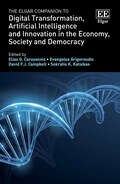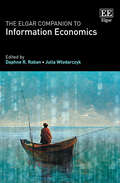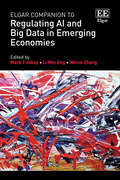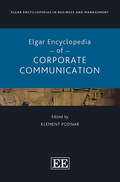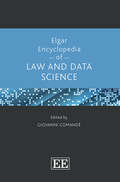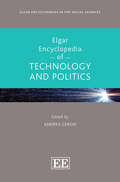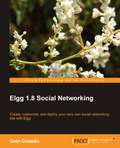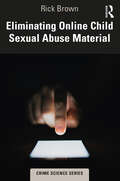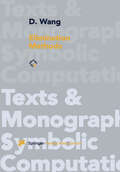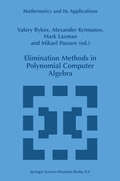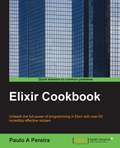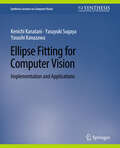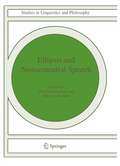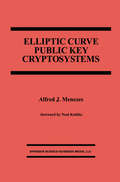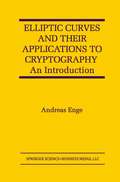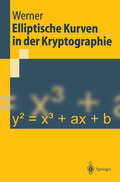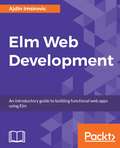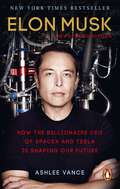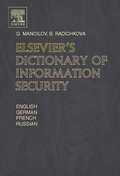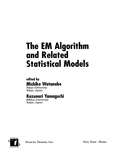- Table View
- List View
The Elgar Companion to Digital Transformation, Artificial Intelligence and Innovation in the Economy, Society and Democracy
Digital transformation continues to accelerate change in all aspects of modern life. This book examines when, where, how, and why artificial intelligence and digital change can boost innovation and transform the economy, society and democracy. It provides a holistic approach to the promotion of the knowledge economy, knowledge society and knowledge democracy.The book is developed based on the Cyber-D4 nexus, which is a conceptual framework of Cyber-Defense, Cyber-Development, Cyber-Democracy, and Cyber-Diplomacy, and it adopts a Quadruple/Quintuple Innovation Helix (Q2IH) approach. This nexus ties new national and industrial cyber strategies, including business strategies for smart cities and the Internet of Things, with the local, national, regional, and global security and economic objectives.Academics, policy makers, practitioners, researchers and students in combined fields of science, technology, innovation and entrepreneurship, digital transformation, artificial intelligence and the future of industry will appreciate the lens through which the chapter authors explore both the minutiae and expansive influence of digital transformation.
The Elgar Companion to Information Economics
The Elgar Companion to Information Economics dexterously navigates this interdisciplinary field of research which celebrates the crucial contribution of information to decision making, market dynamics, and economic well-being. Offering a wealth of conceptual analysis, this erudite Companion embarks on an intellectual journey exploring how the fundamentals of information economics explain rapid developments in the information landscape.Featuring contributions from acclaimed international scholars, chapters expertly analyse the role of information for economic processes. From asymmetric information to AI and digital influencers, they examine the latest developments in research and the practical problems raised by recent innovative technologies while discussing important policy implications. Major themes such as information and disinformation, inequality, information asymmetry, innovation, informational influence, payment and value are examined, and special focus is given to the contrast between scarcity and abundance of information. A number of pressing issues in the processing of information are also identified.This authoritative Companion will serve as a fundamental resource for policymakers, economists, sociologists, information scientists, communication scholars, and political scientists. Postgraduate students and academic researchers interested in the economics of innovation, industrial economics, technology and ICT will similarly benefit from this Companion.
Elgar Companion to Regulating AI and Big Data in Emerging Economies
Committed to highlighting the regulatory needs and priorities of emerging economies in the context of AI and big data, this expertly crafted Companion explores the nature and role of regulation in the Global South from a techno-dependent societal perspective. It not only amplifies the unspoken and underrepresented voices in AI and data regulation scholarly discourse, but also provides a novel approach to otherwise recipient economies in an age of digital transformation.Covering central themes such as regulatory flows, self-regulation and AI ethics, contextual regulation, and regulatory devices, the Companion brings together an array of eminent academics from across the globe. Chapters critically reflect on the nature and role of regulation, charting the tapestry of regulatory influence and capacity, values, and relationships of dependence and vulnerability attendant on advancing AI and mass data sharing. The regulatory challenges facing emerging economies and post-colonial societies are examined, and contributors engage new frames of thinking and solutions from perspectives beyond the interests of techno-colonialism.International and interdisciplinary in scope, this Companion will be an interesting read for academics and students in development studies, law and development, innovation and technology studies, and regulation and governance.
Elgar Encyclopedia of Corporate Communication (Elgar Encyclopedias in Business and Management series)
This comprehensive Encyclopedia captures the intricacies of corporate communication, offering 87 clear, succinct definitions of important concepts within marketing, business, organizational communication and public relations followed by critical, literary analyses of significant research ventures. Emphasizing the interdisciplinary nature of corporate communication, this timely Encyclopedia links topics including selected theories, organization as an entity, corporate branding, corporate responsibilities, corporate misbehaviour, communication processes and tools, stakeholder engagement, corporate communication outcomes and negative corporate association in a clear and accessible format. Eleven key themes are addressed to fully illustrate the complexity of communication in a modern corporate landscape, ranging from selected theories and theoretical approaches to positive and negative corporate associations, providing both practical and conceptual insight. Further recommended readings which demonstrate the expansive nature of topics within corporate communication are provided.The Elgar Encyclopedia of Corporate Communication will be an essential reference text for students focusing on corporate communication and related management disciplines and fields such as communication, corporate identity and reputation, branding, public relations, marketing and organizational behaviour. Due to its real-world implications, it will additionally be of great benefit for practitioners seeking to understand important trends and developments within corporate communication.
Elgar Encyclopedia of Law and Data Science
The Elgar Encyclopedia of Law and Data Science represents a comprehensive mapping of the field. Comprising over 60 entries, it features contributions from eminent global scholars, drawing on expertise from multiple disciplines, including law and data science, economics, computer engineering, physics, biomedical engineering and history, philosophy, neuro-engineering, political science, and geo-informatics.This Encyclopedia brings together jurists, computer scientists, and data analysts to uncover the challenges, opportunities, and fault lines that arise as these groups are increasingly thrown together by expanding attempts to regulate and adapt to a data-driven world. It explains the concepts and tools at the crossroads of the many disciplines involved in data science and law, bridging scientific and applied domains. Entries span algorithmic fairness, consent, data protection, ethics, healthcare, machine learning, patents, surveillance, transparency and vulnerability.Comprehensive yet accessible, this Encyclopedia will be an indispensable resource for scholars of law, data science, artificial intelligence and law and technology. It also contains practical implications for a manifold of users: from domain experts to policy makers, from businesses to practitioners.Key Features:P>The first Encyclopedic coverage of the field of Law and Data ScienceOver 60 entriesEntries organized alphabetically for ease of referenceFull analytical indexInterrelated multidisciplinary perspectivesUnique accessibility for non-experts.
Elgar Encyclopedia of Technology and Politics (Elgar Encyclopedias in the Social Sciences series)
The Elgar Encyclopedia of Technology and Politics is a landmark resource that offers a comprehensive overview of the ways in which technological development is reshaping politics. Providing an unparalleled starting point for research, it addresses all the major contemporary aspects of the field.Divided into five thematic parts, the Encyclopedia investigates the existing academic literature on the main subfields in this area, before introducing innovative digital research methods. It then highlights the pivotal political and non-political actors leading the process of technological innovation, clarifies key concepts and terms in the field, and finally covers emerging and debated topics.This Encyclopedia will be particularly invaluable for early career researchers and advanced students in politics looking for a concise entry point into any of the various ways in which technology shapes the field. It will also be useful for practitioners to familiarise themselves with the analytical opportunities provided by computational social and political sciences.Key Features:Entries written by over 90 scholars from 33 different countries on 5 continentsAccessible starting point for research into the key literature, topics and debates in the fieldIntroduces important new digital methods such as machine learning, text analysis and network analysisDefines and clarifies the meaning of contested terms such as disinformation, echo chambers and fake news
Elgg 1.8 Social Networking
by Cash CostelloThis book provides more than just a step-by-step guide to installing and using Elgg. It includes practical advice gained through experience on what it takes to deploy and maintain an Elgg-based site. If you are a software developer or are familiar with PHP, it provides both a tutorial-based introduction and a quick reference guide so that you can quickly extend and customize Elgg. If you want to create a social networking site using Elgg and do not have a background in software development, this book provides all the information and advice that you need written just for you. If you are a developer, it also contains valuable tutorials and reference material so that you can begin writing code right away.
Eliminating Online Child Sexual Abuse Material (Crime Science Series)
by Rick BrownThis book uses a crime science approach to explore the ways in which child sexual abuse material (CSAM) can be tackled. It describes the CSAM ecosystem, focusing on the ways in which it is produced, distributed and consumed and explores different interventions that can be used to tackle each issue. Eliminating Online Child Sexual Abuse Material provides a methodical approach to unpacking and understanding this growing problem, identifies approaches that have been shown to work and offers alternatives that might be tried. This analysis is set within a crime sciences context that draws on rational choice, routine activities, situation crime prevention and environmental criminology to better understand the nature of the problem and the potential ways in which it may be solved. This book is intended for policy-makers and practitioners working in child protection, online harms and related areas and for students studying sexual violence or internet-related crime. The book will also be of interest to crime scientists as it provides another example of how the approach can be used to understand and reduce crime.
Eliminating Online Child Sexual Abuse Material (Crime Science Series)
by Rick BrownThis book uses a crime science approach to explore the ways in which child sexual abuse material (CSAM) can be tackled. It describes the CSAM ecosystem, focusing on the ways in which it is produced, distributed and consumed and explores different interventions that can be used to tackle each issue. Eliminating Online Child Sexual Abuse Material provides a methodical approach to unpacking and understanding this growing problem, identifies approaches that have been shown to work and offers alternatives that might be tried. This analysis is set within a crime sciences context that draws on rational choice, routine activities, situation crime prevention and environmental criminology to better understand the nature of the problem and the potential ways in which it may be solved. This book is intended for policy-makers and practitioners working in child protection, online harms and related areas and for students studying sexual violence or internet-related crime. The book will also be of interest to crime scientists as it provides another example of how the approach can be used to understand and reduce crime.
Elimination Methods (Texts & Monographs in Symbolic Computation)
by D. WangThe development of polynomial-elimination techniques from classical theory to modern algorithms has undergone a tortuous and rugged path. This can be observed L. van der Waerden's elimination of the "elimination theory" chapter from from B. his classic Modern Algebra in later editions, A. Weil's hope to eliminate "from algebraic geometry the last traces of elimination theory," and S. Abhyankar's sug gestion to "eliminate the eliminators of elimination theory. " The renaissance and recognition of polynomial elimination owe much to the advent and advance of mod ern computing technology, based on which effective algorithms are implemented and applied to diverse problems in science and engineering. In the last decade, both theorists and practitioners have more and more realized the significance and power of elimination methods and their underlying theories. Active and extensive research has contributed a great deal of new developments on algorithms and soft ware tools to the subject, that have been widely acknowledged. Their applications have taken place from pure and applied mathematics to geometric modeling and robotics, and to artificial neural networks. This book provides a systematic and uniform treatment of elimination algo rithms that compute various zero decompositions for systems of multivariate poly nomials. The central concepts are triangular sets and systems of different kinds, in terms of which the decompositions are represented. The prerequisites for the concepts and algorithms are results from basic algebra and some knowledge of algorithmic mathematics.
Elimination Methods in Polynomial Computer Algebra (Mathematics and Its Applications #448)
by V. Bykov A. Kytmanov M. Lazman Mikael PassareThe subject of this book is connected with a new direction in mathematics, which has been actively developed over the last few years, namely the field of polynomial computer algebra, which lies at the intersection point of algebra, mathematical analysis and programming. There were several incentives to write the book. First of all, there has lately been a considerable interest in applied nonlinear problems characterized by multiple sta tionary states. Practical needs have then in their turn led to the appearance of new theoretical results in the analysis of systems of nonlinear algebraic equations. And finally, the introduction of various computer packages for analytic manipulations has made it possible to use complicated elimination-theoretical algorithms in prac tical research. The structure of the book is accordingly represented by three main parts: Mathematical results driven to constructive algorithms, computer algebra realizations of these algorithms, and applications. Nonlinear systems of algebraic equations arise in diverse fields of science. In particular, for processes described by systems of differential equations with a poly nomial right hand side one is faced with the problem of determining the number (and location) of the stationary states in certain sets.
Elixir Cookbook
by Paulo A PereiraThis book is intended for users with some knowledge of the Elixir language syntax and basic data types/structures. Although this is a cookbook and no sequential reading is required, the book's structure will allow less advanced users who follow it to be gradually exposed to some of Elixir's features and concepts specific to functional programming. To get the most out of this book, you need to be well versed with Erlang.
Ellipse Fitting for Computer Vision: Implementation and Applications (Synthesis Lectures on Computer Vision)
by Margrit BetkeBecause circular objects are projected to ellipses in images, ellipse fitting is a first step for 3-D analysis of circular objects in computer vision applications. For this reason, the study of ellipse fitting began as soon as computers came into use for image analysis in the 1970s, but it is only recently that optimal computation techniques based on the statistical properties of noise were established. These include renormalization (1993), which was then improved as FNS (2000) and HEIV (2000). Later, further improvements, called hyperaccurate correction (2006), HyperLS (2009), and hyper-renormalization (2012), were presented. Today, these are regarded as the most accurate fitting methods among all known techniques. This book describes these algorithms as well implementation details and applications to 3-D scene analysis. We also present general mathematical theories of statistical optimization underlying all ellipse fitting algorithms, including rigorous covariance and bias analyses and the theoretical accuracy limit. The results can be directly applied to other computer vision tasks including computing fundamental matrices and homographies between images. This book can serve not simply as a reference of ellipse fitting algorithms for researchers, but also as learning material for beginners who want to start computer vision research. The sample program codes are downloadable from the website: https://sites.google.com/a/morganclaypool.com/ellipse-fitting-for-computer-vision-implementation-and-applications.
Ellipsis and Nonsentential Speech (Studies in Linguistics and Philosophy #81)
by Reinaldo Elugardo Robert J. StaintonThe papers in this volume address two main topics: Q1: What is the nature, and especially the scope, of ellipsis in natural l- guage? Q2: What are the linguistic/philosophical implications of what one takes the nature/scope of ellipsis to be? As will emerge below, each of these main topics includes a large sub-part that deals speci?cally with nonsentential speech. Within the ?rst main topic, Q1, there arises the sub-issueofwhethernonsententialspeechfallswithinthescopeofellipsisornot;within the second main topic, Q2, there arises the sub-issue of what linguistic/philosophical implications follow, if nonsentential speech does/does not count as ellipsis. I. THE NATURE AND SCOPE OF ELLIPSIS A. General Issue: How Many Natural Kinds? There are many things to which the label ‘ellipsis’ can be readily applied. But it’s quite unclear whether all of them belong in a single natural kind. To explain, consider a view, assumed in Stainton (2000), Stainton (2004a), and elsewhere. It is the view that there are fundamentally (at least) three very different things that readily get called ‘ellipsis’, each belonging to a distinct kind. First, there is the very broad phenomenon of a speaker omitting information which the hearer is expected to make use of in interpreting an utterance. Included therein, possibly as a special case, is the use of an abbreviated form of speech, when one could have used a more explicit expression. (See Neale (2000) and Sellars (1954) for more on this idea.
Elliptic Curve Public Key Cryptosystems (The Springer International Series in Engineering and Computer Science #234)
by Alfred J. MenezesElliptic curves have been intensively studied in algebraic geometry and number theory. In recent years they have been used in devising efficient algorithms for factoring integers and primality proving, and in the construction of public key cryptosystems. Elliptic Curve Public Key Cryptosystems provides an up-to-date and self-contained treatment of elliptic curve-based public key cryptology. Elliptic curve cryptosystems potentially provide equivalent security to the existing public key schemes, but with shorter key lengths. Having short key lengths means smaller bandwidth and memory requirements and can be a crucial factor in some applications, for example the design of smart card systems. The book examines various issues which arise in the secure and efficient implementation of elliptic curve systems. Elliptic Curve Public Key Cryptosystems is a valuable reference resource for researchers in academia, government and industry who are concerned with issues of data security. Because of the comprehensive treatment, the book is also suitable for use as a text for advanced courses on the subject.
Elliptic Curves and Their Applications to Cryptography: An Introduction
by Andreas EngeSince their invention in the late seventies, public key cryptosystems have become an indispensable asset in establishing private and secure electronic communication, and this need, given the tremendous growth of the Internet, is likely to continue growing. Elliptic curve cryptosystems represent the state of the art for such systems. Elliptic Curves and Their Applications to Cryptography: An Introduction provides a comprehensive and self-contained introduction to elliptic curves and how they are employed to secure public key cryptosystems. Even though the elegant mathematical theory underlying cryptosystems is considerably more involved than for other systems, this text requires the reader to have only an elementary knowledge of basic algebra. The text nevertheless leads to problems at the forefront of current research, featuring chapters on point counting algorithms and security issues. The Adopted unifying approach treats with equal care elliptic curves over fields of even characteristic, which are especially suited for hardware implementations, and curves over fields of odd characteristic, which have traditionally received more attention. Elliptic Curves and Their Applications: An Introduction has been used successfully for teaching advanced undergraduate courses. It will be of greatest interest to mathematicians, computer scientists, and engineers who are curious about elliptic curve cryptography in practice, without losing the beauty of the underlying mathematics.
Elliptische Kurven in der Kryptographie (Springer-Lehrbuch)
by Annette WernerDieses Lehrbuch bietet eine elementare Einführung in ein mathematisch anspruchsvolles Gebiet der modernen Kryptographie, das zunehmend an praktischer Bedeutung gewinnt.Die relevanten Tatsachen über elliptische Kurven und Public-Key-Kryptographie werden ausführlich erläutert.Dabei werden nur geringe Vorkenntnisse vorausgesetzt, um den Text für Studierende der Mathematik und Informatik ab dem 5. Semester sowie für Praktiker zugänglich zu machen.
Elm Web Development: An Introductory Guide To Building Functional Web Apps Using Elm
by Ajdin ImsirovicExplore why ELM is a great alternative to using pure JavaScript and other JS-based solutions by building complete apps and websites.About This BookDevelop your own scalable and modular web applications with Elm to make web development less messy compared to your JavaScript appsCreate personal portfolio website, a weather application, and a unit conversion website, and integrate your Elm apps with Rails 5Boost the performance of your application with no runtime exceptions and JavaScript interoperabilityWho This Book Is ForThis book is for frontend web developers who want to learn a simpler way of developing their applications. A knowledge of the basics of CSS and Bootstrap is required.What You Will LearnProgramming with the Elm language, its syntax and core conceptsUsing Elm for front end web development projectsDeveloping complete websites with ElmDecoding JSON into ElmIntegrating Elm with the standard front end web development technologiesIntegrating Elm with back-end frameworksTesting your applications in ElmIn DetailWeb development with JavaScript usually involves dealing with performance and maintenance issues. JavaScript fatigue makes it difficult for many developers to keep up with the increasing complexity posed by the multitude of JavaScript frameworks with changing versions, and the need to use different tools such as task runners, module bundlers, compilers, testing suites, linting and debuggers. Elm is an easy-to-learn, functional programming language that simplifies web development by eliminating the complexity associated with using JavaScript for web development. Elm is a statically typed language and thus makes a front end web developer's life easier by preventing run-time errors.You will begin by seeing the bigger picture of where Elm fits into the web development world and learning the basics of Elm programming. Firstly, you will get a taste for web development with Elm by developing a simple fizz-buzz app. Next you will get hands-on with advanced Elm concepts as you develop your own personal blogging website, a unit conversion app and a weather app with Elm. Finally, you will also learn how to integrate Elm with a Rails 5 app with the help of Webpack. By the end of the book you will have learned Elm programming, and its applications, and will appreciate how Elm simplifies web development for you.Style and approachThis book teaches the Elm language in a learning-by-doing approach through the implementation of five different web development projects.
Elon Musk: How the Billionaire CEO of SpaceX and Tesla is Shaping our Future
by Ashlee VanceSouth African born Elon Musk is the renowned entrepreneur and innovator behind PayPal, SpaceX, Tesla, and SolarCity. Musk wants to save our planet; he wants to send citizens into space, to form a colony on Mars; he wants to make money while doing these things; and he wants us all to know about it. He is the real-life inspiration for the Iron Man series of films starring Robert Downey Junior.The personal tale of Musk’s life comes with all the trappings one associates with a great, drama-filled story. He was a freakishly bright kid who was bullied brutally at school, and abused by his father. In the midst of these rough conditions, and the violence of apartheid South Africa, Musk still thrived academically and attended the University of Pennsylvania, where he paid his own way through school by turning his house into a club and throwing massive parties.He started a pair of huge dot-com successes, including PayPal, which eBay acquired for $1.5 billion in 2002. Musk was forced out as CEO and so began his lost years in which he decided to go it alone and baffled friends by investing his fortune in rockets and electric cars. Meanwhile Musk’s marriage disintegrated as his technological obsessions took over his life ...Elon Musk is the Steve Jobs of the present and the future, and for the past twelve months, he has been shadowed by tech reporter, Ashlee Vance. Elon Musk: How the Billionaire CEO of Spacex and Tesla is Shaping our Future is an important, exciting and intelligent account of the real-life Iron Man.
Elsevier's Dictionary of Information Security
by G. Manoilov B. RadichkovaThe dictionary will contain terms currently used in the broad fields of electronics data protection and data management in today's interconnected world - the Global Village. The terminology will cover all aspects of the modern technology's best practices in multiple subfields, namely: physical (hardware and perimeter) security, wired and wireless telecommunication infrastructure security, internet (e-commerce and business-to-business) security, anti-virus and anti-spyware applications, virtual private networking, theory and practices of cryptography, corporate security policies'methodology, design, implementation and enforcement.5000 terms in English, German, French and Russian* a valuable reference tool for both the general public and the industry experts* can be used as knowledge support in theoretical projects * could also serve as a handy desktop reference book in day-to-day operations in a multilingual environment
Eltern als Mediendidaktiker: Elterlicher Einfluss auf die bildungsbezogene Computer- und Internetnutzung von Kindern
by Claudia BörnerDie empirische Studie von Claudia Börner beinhaltet die differenzierte Erfassung und Analyse elterlichen Unterstützungsverhaltens im Kontext der bildungsbezogenen Nutzung digitaler Medien durch Grundschüler. Neben der Darstellung, wie sich digital gestützte Bildungs- und Lernprozesse im häuslichen Lernumfeld gestalten, wurden Faktoren analysiert, die einen Einfluss auf das elterliche Unterstützungsverhalten haben. Die empirischen Befunde geben Aufschluss über die Notwendigkeit einer handlungspraktischen Intervention zur Nutzung digitaler Bildungsmedien an der Schnittstelle von Elternhaus und Schule. Dazu wurden auf Basis der Forschungsergebnisse medienpädagogische Empfehlungen abgeleitet, die Eltern, Lehrer und die Bildungspolitik adressieren.
The EM Algorithm and Related Statistical Models (Statistics: A Series Of Textbooks And Monographs #170)
by Michiko Watanabe Kazunori YamaguchiExploring the application and formulation of the EM algorithm, The EM Algorithm and Related Statistical Models offers a valuable method for constructing statistical models when only incomplete information is available, and proposes specific estimation algorithms for solutions to incomplete data problems. The text covers current topics including statistical models with latent variables, as well as neural network models, and Markov Chain Monte Carlo methods. It describes software resources valuable for the processing of the EM algorithm with incomplete data and for general analysis of latent structure models of categorical data, and studies accelerated versions of the EM algorithm.
Email (Object Lessons)
by Randy MalamudObject Lessons is a series of short, beautifully designed books about the hidden lives of ordinary things. Do you feel your consciousness, your attention, and your intelligence (not to mention your eyesight) being sucked away, byte by byte, in a deadening tsunami of ill-composed blather, corporate groupthink, commercial come-ons, and other meaningless internet flotsam? Do your work life and your social life, hideously conjoined in your inbox, drag each other down in a surreal cycle of neverending reposts, appointments, and deadlines?Sometime in the mid-1990s, we began, often with some trepidation, to enroll for a service that promised to connect us-electronically and efficiently-to our friends and lovers, our bosses and merchants. If it seemed at first like simply a change in scale (our mail would be faster, cheaper, more easily distributed to large groups), we now realize that email entails a more fundamental alteration in our communicative consciousness. Despite its fading relevance in the lives of the younger generation in the face of an ever-changing array of apps and media, email is probably here to stay, for better or worse.Object Lessons is published in partnership with an essay series in The Atlantic.
Email (Object Lessons)
by Randy MalamudObject Lessons is a series of short, beautifully designed books about the hidden lives of ordinary things. Do you feel your consciousness, your attention, and your intelligence (not to mention your eyesight) being sucked away, byte by byte, in a deadening tsunami of ill-composed blather, corporate groupthink, commercial come-ons, and other meaningless internet flotsam? Do your work life and your social life, hideously conjoined in your inbox, drag each other down in a surreal cycle of neverending reposts, appointments, and deadlines?Sometime in the mid-1990s, we began, often with some trepidation, to enroll for a service that promised to connect us-electronically and efficiently-to our friends and lovers, our bosses and merchants. If it seemed at first like simply a change in scale (our mail would be faster, cheaper, more easily distributed to large groups), we now realize that email entails a more fundamental alteration in our communicative consciousness. Despite its fading relevance in the lives of the younger generation in the face of an ever-changing array of apps and media, email is probably here to stay, for better or worse.Object Lessons is published in partnership with an essay series in The Atlantic.
Email Marketing: An Hour a Day
by Jeanniey Mullen David DanielsIf the idea of starting an email marketing campaign overwhelms you, the authors of Email Marketing: An Hour a Day will introduce you to email marketing basics, demonstrate how to manage details and describe how you can track and measure results. Case studies, step-by-step guides, checklists, quizzes and hands-on tutorials will help you execute an email marketing campaign in just one hour a day. When you feel comfortable with the basics, learn how to use video and audio enabled email, implement tools like mobile devices and leverage social networks.
